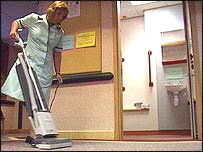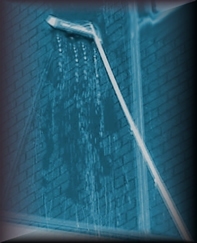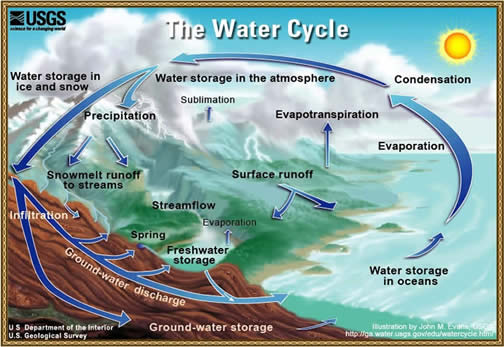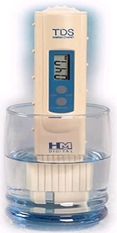A TDS meter is required to identify the
total quantity of
minerals that are dissolved in your
water.
|
TDS: Total Dissolved
Solids.
This hand held meter
will give a three digit reading.
|
|
If you were to test the water at
your tap, the meter would probably show a reading of
between 035 parts per million (035 ppm) and 600 parts
per million (600 ppm)
This is ok for drinking, but it is not
of any use at all for window cleaning!
|
If you want to wash glass and end
up with perfectly clean windows, all the minerals
need to be filtered or extracted from the water,
giving a TDS reading of 000 ppm indicating zero
mineral content or total demineralization.
|
The costs and methods involved
in demineralizing water with a TDS of 035 ppm is far
less than water with a higher TDS of 600 ppm
Benefits to you:

Better cleaning results
|  |
Windows stay cleaner longer |
 |
Reduced disturbance to your premises |
 |
Increased privacy; no more faces peering through your upstairs windows |
 |
Environmentally friendly; eliminating the need for detergents and chemicals |
Reverse Osmosis
In simple terms, reverse
osmosis is the process of pushing a solution
through a filter that traps the solute on one side
and allows the pure solvent to be obtained from
the other side. More formally, it is the process
of forcing a solvent from a region of high solute
concentration through a membrane to a region of
low solute concentration by applying a pressure in
excess of the osmotic pressure. The membrane here
is semipermeable, meaning it allows the passage of
solvent but not of solute.
The membranes
used for reverse osmosis have no pores, the
separation takes place in a dense polymer layer of
only microscopic thickness. In most cases the
membrane is designed to only allow water to pass
through. The water goes into solution in the
polymer of which the membrane is manufactured, and
crosses it by diffusion. This process requires
that a high pressure be exerted on the high
concentration side of the membrane.
How R/O Works
Reverse Osmosis uses a very
fine filter or membrane. The membrane is so fine
that the pores only allow passage of water
molecules. The dissolved impurities do not pass
through the membrane.These impurities can include
calcium, sodium, and other elements that normal
water can contain. The membrane itself is made
from a synthetic material, such as polyamide or
polysulfone. This membrane is delicate and could
be damaged by organic matter, iron, chlorine, and
other impurities found in normal tap water. These
impurities must be removed by pre- filters.
This membrane, begins as a large flat
sheet, is spiral wound into a tube , and housed in
a pressure vessel. The pressure of the water
entering the vessel is sufficient to squeeze the
water molecules through the membrane to produce a
flow of pure water. The remaining water passess
through the vessel carrying the impurities with it
and exits to waste. This is known as reject.
The reject water has a higher content of
dissolved solids but is not hazardous and can be
safely drained away.
RO membranes will
produce a large quantity of pure water cheaply.
Keep these points in mind:
- Change your filters regularly
- If the water in the RO unit freezes, that
unit will be permanently damaged
- Soften the water. Water softners exchange
calcium and magnesium ions with sodium. Sodium
helps hold the other remaining suspended solids
in the solution, preventing them from adhering
to the membrane surface. A water softner will
prolong the membrane's
life.
Deionized water (DI water)
Deionized water
(DI water or de-ionized water is water that lacks
ions, such as cations from sodium, calcium, iron,
copper and anions such as chloride and bromide.
This means it has been purified from all other
ions but H3O+ and OH-, but it may still contain
other non-ionic types of impurities such as
organic compounds. This type of water is produced
using an ion exchange process.
Deionized
water is similar to distilled water, in that it is
useful for scientific experiments where the
presence of impurities may be undesirable.
The lack of ions also causes the water's
resistivity to increase. Ultra-pure deionized
water can have a theoretical maximum resistivity
up to 18.3 M-·cm-1, compared to around 15 k-·cm-1
for common tap water. Deionized water's high
resistivity allows it, in some very highly
speciallized instances, to be used as a coolant in
direct contact with high-voltage electrical
equipment. Because of its high relative dielectric
constant (~80), it is also used (for short
durations) as a high voltage dielectric in many
pulsed power applications, such as Sandia's Z
Machine.
Deionized water easily changes pH
while storing it. This is because carbon dioxide
from the air dissolves in the water and causes a
drop in pH by forming carbonic acid H2CO3. Boiling
the water will remove the carbon dioxide to
restore the pH.
The uses of ultrapure
deionized water are many and varied, often having
application in scientific experimentation such as
when very pure chemical reaget solutions are
needed in a chemical reaction or when a biological
growth medium needs to be sterile and very pure.
DI water is also used extensively in the
semiconductor industry to process and clean
silicon wafers and sometimes in the optics
industry when very highly clean optical surfaces
are required for coating.
DI water is also
often used as a final rinse when washing
scientific glassware. Deionized water is very
often used as an "ingredient" in many cosmetics
and pharmaceuticals where it is sometimes referred
to as "aqua" on product ingredient labels. This
use again owes to its lack of potential for
causing undesired chemical reactions due to
impurities. A recent use of DI water is that of
window cleaning where because it contains so
little dissolved solutes so the glass dries
without leaving any spots.
 CSS is more than a company contracted to clean your premises, we recognise the importance of providing a clean and hygienic place of work for your employees and guests, and aim to give a lasting impressions of a fresh, clean working environment for all your visiting clients.
CSS is more than a company contracted to clean your premises, we recognise the importance of providing a clean and hygienic place of work for your employees and guests, and aim to give a lasting impressions of a fresh, clean working environment for all your visiting clients.
CSS understands the needs of its clients,We value your investment and have the capability to complete the project on time,we talor our services to suite our clients needs
Initial and final Cleaning of new buildings domestic and commercial
This is a valuable service to builders or individuals who are building new premises / extensions. Complete cleaning of house or building - This eases the stress of moving in!
Construction and maintenance clean ups, deep clean of toilets, rooms, windows, floors, etc the schedule can be adapted to suit the clients needs
Estate maintenance and Commercial Cleaning
We offer a round the clock cleaning service, an initial clean and follow up cleaning every day thereafter. Our standards of cleaning commercial properties are of the highest standard. Each and every client we have aquired are treated like they are the only one. Again all uniformed staff, cleaning products and weekly inspections are provided by us to ensure the highest standard of workmanship.
House Cleaning
Cleaning of the whole house from top to bottom. Kitchen presses, appliances, Oven's, Microwaves, Tiles, Showers, Toilets, Floors, all Internal Doors and skirting boards.
We specialize in total after-cleaning from top to bottom post house extensions, morning after the party! Working too hard and cannot cope with house work, leave it to us. The service we provide will not be matched by any other cleaning company
Offices
Office cleaning daily or weekly, We provide a full cleaning service for your office, canteen, toilets etc
HOME








